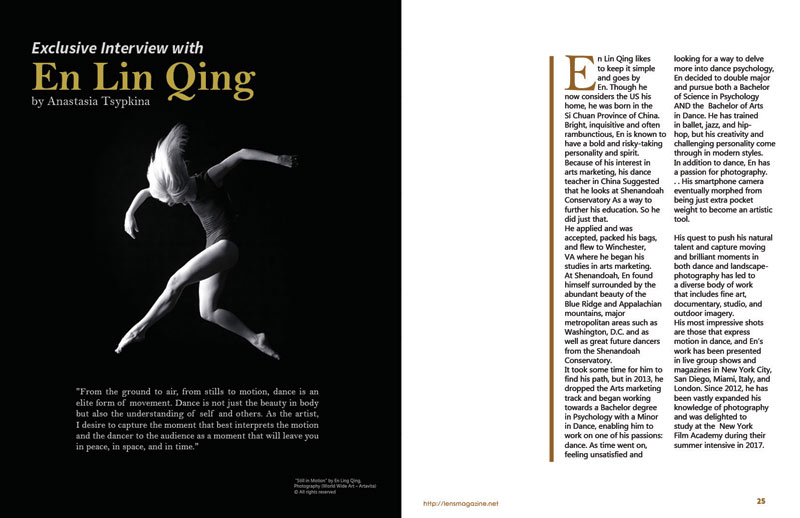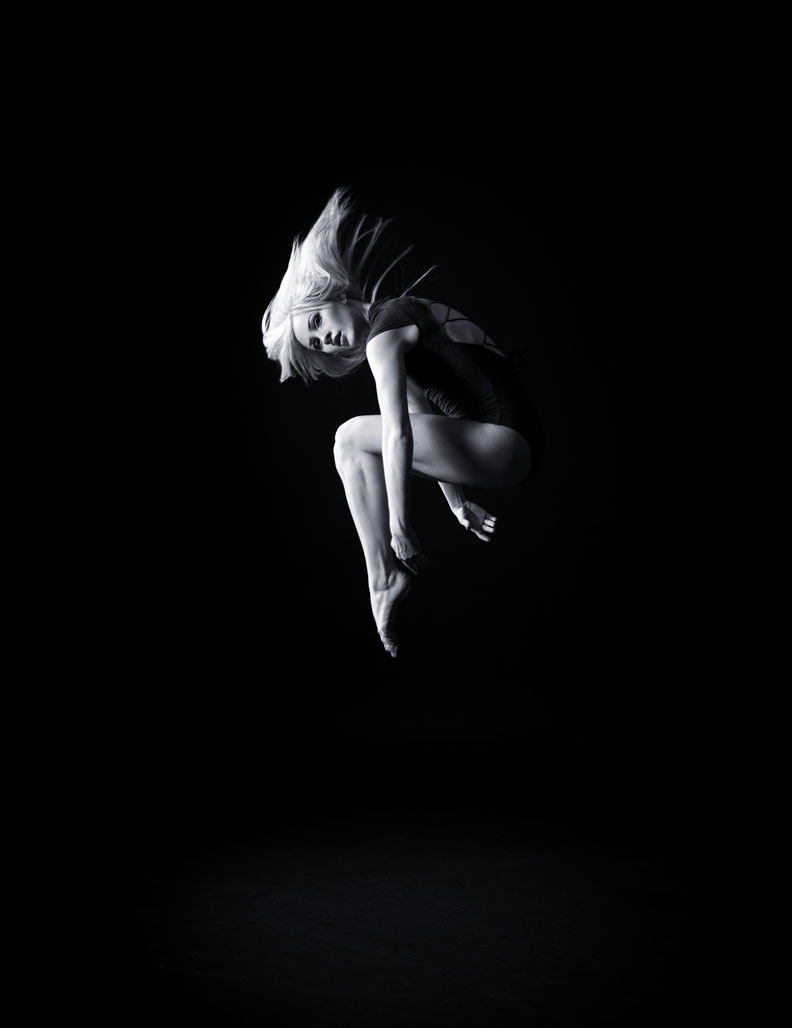Exclusive Interview with
En Lin Qing
by Anastasia Tsypkina
“From the ground to air, from stills to motion, dance is an elite form of movement. Dance is not just the beauty in body but also the understanding of self and others. As the artist,
I desire to capture the moment that best interprets the motion and the dancer to the audience as a moment that will leave you in peace, in space, and in time.”

En Lin Qing . Special Interview on Lens Magazine Issue 39
En Lin Qing likes to keep it simple and goes by En. Though he now considers the US his home, he was born in the Si Chuan Province of China. Bright, inquisitive and often rambunctious, En is known to have a bold and risky-taking personality and spirit.
Because of his interest in arts marketing, his dance teacher in China Suggested that he looks at Shenandoah Conservatory As a way to further his education. So he did just that.
He applied and was accepted, packed his bags, and flew to Winchester, VA where he began his studies in arts marketing. At Shenandoah, En found himself surrounded by the abundant beauty of the Blue Ridge and Appalachian mountains, major metropolitan areas such as Washington, D.C. and as well as great future dancers from the Shenandoah Conservatory.
It took some time for him to find his path, but in 2013, he dropped the Arts marketing track and began working towards a Bachelor degree in Psychology with a Minor in Dance, enabling him to work on one of his passions: dance. As time went on, feeling unsatisfied and looking for a way to delve more into dance psychology, En decided to double major and pursue both a Bachelor of Science in Psychology AND the Bachelor of Arts in Dance. He has trained in ballet, jazz, and hip-hop, but his creativity and challenging personality come through in modern styles. In addition to dance, En has a passion for photography. . . His smartphone camera eventually morphed from being just extra pocket weight to become an artistic tool.

En Lin Qing Special Interview on Lens Magazine Issue 39
His quest to push his natural talent and capture moving and brilliant moments in both dance and landscape-photography has led to a diverse body of work that includes fine art, documentary, studio, and outdoor imagery.
His most impressive shots are those that express motion in dance, and En’s work has been presented in live group shows and magazines in New York City, San Diego, Miami, Italy, and London. Since 2012, he has been vastly expanded his knowledge of photography and was delighted to study at the New York Film Academy during their summer intensive in 2017.
Today a creative person should be a multi-handed Shiva and be able to do different things. For example, you are an artist, photographer, dancer… Who else are you?
En: I’m also a psychologist, I got a bachelor’s degree in psychology. Also, I’m filming with my friend. We started a company helping students, to learn master-classes, to learn basics of photography and introduce them to the photo sell market. I record dancing and make a production of it. After the school they are supposed to know how to market themselves through the photo shoot, how to use material as well.
Where did you learn to take photos?
En: I started photo shooting because I had a camera – that’s it! I, actually, took horrible pictures of people/ It was the worst moment I could ever capture! (Laugh) And then start progressing it, I focused more on Landscapes because I don’t want to deal with people.
Do you remember how you presented your works in the world of photography for the first time? What comments did you get, what was the reaction?
En: At the beginning my pictures were no good enough, but critics looked at them and act like parents do, saying: “Oh. It’s a great job, keep on!” So I got more compliments than critics, but people just didn’t want to hurt my feelings. And during the next 2 years and a half until now I’ve been practicing and I had no publicities. But suddenly, this year everything has changed.
Let’s discuss the style of your works? Is there something or someone who influenced on your professional vision of a photographer?
En: It’s some of the people who are my mentors. I’m fond of the idea of capturing emotion or feeling in the moment. It’s not about right or wrong. I approve what I’m doing and I’m standing by it. So I don’t go back: It’s my work and I love my work. So my mentors showed to me that the dance world is a presenting yourself as a physical being and whatever you do is whatever you do. It could be wrong or right, but you’re being you.
What about your dancing career and why you ended it?
En: I started dancing in a high school. Before it, I was just doing sports. But then I opened a dancing world and I thought that it might be a great idea to try it. During college years I had other things I should have done. When I move to the USA in the age of 18 in 2012 (I was born and raised in China), I felt a bit like a fish out of the water. I felt more freedom but at the same time, I realized that I need something different to do in different genres. So I was about to learning photography.

En Lin Qing Exclusive Interview on Lens Magazine Issue 39
How do you feel while watching all these amazing dancing shows, performances that you shoot but don’t participate in. Are you getting jealous or you get it naturally, realizing that life gives us what we suppose to be given?
En: I guess, I feel more inspired than anything else. For me this work is a challenge. I want to take a motion itself because it looks quite organic.

En Lin Qing Red Dot Miami Exclusive Interview on Lens Magazine Issue 39
What dancing style you would like to shoot except ballet? What difficulties you suspect you could run into?
En: I like contemporary style of dancing. For me it seems more free and natural. Every other picture will be the same if you’re shooting ballet dancing or any other kind of academic dancing. It’s all about copy and paste, copy and paste. Everybody is doing the same thing with no exploring themselves. So when it goes about contemporary dancing art, the movements in it are more organic, freer. The complicity might be in getting the idea, first of all, because everybody speaks about different ideas: what I see, what I want vs. what they see, what they want. I always tell my clients, that it is a collaboration, what we should come up with. And it’s not 100 percent what I want or 100 percent what they want – we only can share what we know and explain
What was the last show you’ve seen that impressed you a lot?
En: So far it mostly have been the school, conservatory performances I’ve visited. But honestly, I should admit I’m never satisfied. I feel like either I could do better, or they could do better. So the best shows haven’t happened yet.
I should mention that your series Land of dreams is an impressive one! Tell our readers how you came up with an idea making such a photo-trip happen?
En: It all happened spontaneously! I was planning to waste my summertime somehow and one day I woke up in my friend’s house and decided to make a trip with two of us shooting and travelling both. From the Eastern part of America I went to the Western part and met up with my friend in Chicago. He was filming, I was shooting and it was an amazing time lasted 3 months! I went across the different landscape and the challenge was to work with what you got. You have no time to stay in the same place for a long time waiting for the perfect picture or light or whatever. No matter how cold or dark is outside; we had to take pictures every single day! The whole trip took 4 months and a half.
The subject of the upcoming issue to “the BIG B&W issue 2017”, as we always publish in the last month of the year. You seem to have the right content for this issue, and your BW works would fit perfectly. What do you think about this style in photo art? What concept you try to send to the audience, while using B/W filters?
En: To me Black and white style is an innocence and very simple to get, very straightforward. There is no other noise or any other information. So when you look at the b/w pictures, you won’t be distracted by colors. So you pay attention to the shape, to the detail or lines.
What tasks you consider as the most difficult ones when it goes to B/W photography?
En: I think, both styles in photography – with color or b/w are difficult on the different level. You need to understand the graphic side of it.
From your blog, I found out that the field of your work is greatly abroad. What direction you would like to try yet? Can we wait for more, new, experiments?
En: I’d like to try fashion photography. To focus on body parts and to see, what’s going to happen. I remember, I was taking courses in New York and they wanted me to choose one field to follow: Fine Art or Commercial. In my mind, when someone gives me a choice, I always ask, why can’t I have both? Why I have to be only commercial, why can I be on both sides?
I might have another perception of art. You know, sometimes I think that Leonardo made all his masterpieces not for a purpose. He just did it. I’m not sure that he depicted a man because he felt depressed or broken hearted. No! He just painted it as it is. And that’s how I do my works – I don’t need great stories. I just do what I feel I must do.
What advice can you give the emerging starting photographers in the field you work?
En: First of all, I don’t think I’m experienced enough to give advice. But if I would… I’d say “try more”. Just think differently. Think free. If you want, you can try something commercial but in the fine art stream. Just challenge yourself. That’s what my teachers always told me.
Would you tell us what things this year has brought to you? New projects, people or experience? What gift would you like to get from for Santa?
En: This year was my opening. My friends- coworkers, they helped me to establish my ideas and the way they can be presented. I tried to show people something that they haven’t seen before. This year brought to me the idea that the world of art is diverse. You can get a bad review or a good one. It’s unpredictable. I value people who appreciate my works, but also who didn’t. This year brought a lot of questions that I never had before.
And as for Santa, if he exists… I would ask for new cameras or technical stuff which I always need. So If I could choose anything, it will be equipments.
Read the full article on Lens Magazine Issue #39

